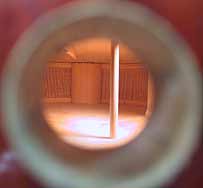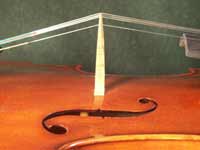The soundpost is the spruce dowel which transfers sound vibrations from the top of the violin to the back.

soundpost as seen from the endpin hole
|
Changes in humidity cause the top and back of an instrument expand and contract. Since these pieces are glued onto the sides all the way around, the height of the arching varies slightly. This can cause the soundpost to be either too tight or too loose, resulting in a variation in the quality of the sound. If you notice the sound of your instrument change suddenly, especially after a drastic change in surrounding humidity, don't despair - It may change back again. You may, however, need to have the soundpost adjusted.
In drier weather, a tightly placed soundpost is compounded by the fact that the wood comprising the top and back of the instrument become harder as they dry out. So even if a tight soundpost is moved inward to relieve excess tension, you will not achieve the same sound produced in more humid conditions. Some instruments simply sound better in more humid weather, and some in dryer weather, depending on the rigidity of the wood. A Dampit can help decrease the fluctuations in humidity experienced by the instrument.

Post position
|
In extreme cases of low humidity, the soundpost can exert so much pressure on the top and back that exposure to additional stress can cause them to crack where they are in contact with the post. This is a serious situation for the instrument because it is very expensive to repair and devalues the instrument significantly.

